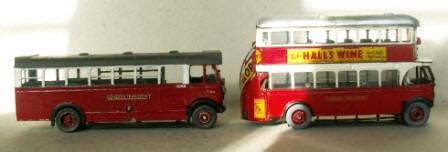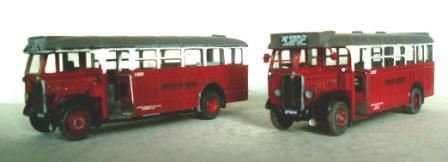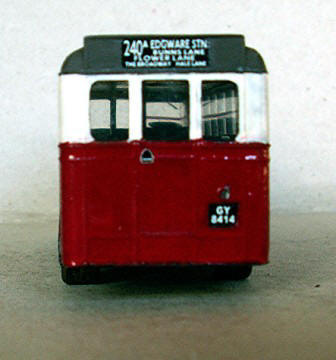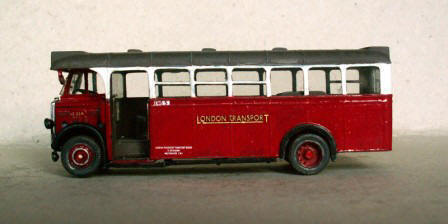TILLING AEC REGAL T307-318 - KIT NO. 5A
Review by Alan Purssey
Continuing
the series of
London single deckers from the late 1920s and early 1930s, this is this
fourth model from MBC Resin, a Tilling-designed AEC Regal owned by
London General.
Thomas Tilling London had been operating motorbuses alongside the London
General Omnibus Company since 1904 and in 1913 an agreement between the
LGOC and Tilling was reached limiting the fleet to 150. In 1923 a new
agreement came into force doubling the Tilling fleet by allowing them 5% of
the London pool. By the late 1920s Tilling, along with the London General, were
turning their thoughts to modernising the fleet, and in 1930-31 191
buses were built for them, with a double deck body by Dobson still with
an open staircase (ST922 is an example preserved at Cobham museum).
 The LGOC owned a further 102 double deck buses operated by Tilling
for the General that were in need of replacement. In 1933, 102 buses
were ordered with Tilling-designed extra length bodies, and these were included in
the
STL class. Only 80 were to be delivered before the formation of London
Transport in 1933 with the remainder being cancelled.
The LGOC owned a further 102 double deck buses operated by Tilling
for the General that were in need of replacement. In 1933, 102 buses
were ordered with Tilling-designed extra length bodies, and these were included in
the
STL class. Only 80 were to be delivered before the formation of London
Transport in 1933 with the remainder being cancelled.
In the early 1932 the LGOC ordered and bought twelve new Tilling-designed single deck
AEC
Regals to be operated for them by Tilling. They entered service on route 109
through Bromley in September 1932. The route number was later changed to 227 in
LT service. They were absorbed into the LPTB operating stock in October
1933.
 These
26ft long single deck buses adopted many of the design features found on
the double deck variety (picture 1). In Tilling fashion they had narrow
rounded windows with six bays, and included a double-beading just below
the window line. A forward entrance was fitted with the usual central
emergency exit at the rear. They were initially fitted with seating for
28 passengers. These buses were easily recognisable by the large
destination screens fitted to both front and rear, and differed in many
respects to the General design (picture 2). The full screen was only
utilised for brief time in Tilling service.
These
26ft long single deck buses adopted many of the design features found on
the double deck variety (picture 1). In Tilling fashion they had narrow
rounded windows with six bays, and included a double-beading just below
the window line. A forward entrance was fitted with the usual central
emergency exit at the rear. They were initially fitted with seating for
28 passengers. These buses were easily recognisable by the large
destination screens fitted to both front and rear, and differed in many
respects to the General design (picture 2). The full screen was only
utilised for brief time in Tilling service.
This model is based on the bus as it appeared in London Transport
service. They were re-built as 30-seaters with the sidelights
repositioned from the roofline into the front bulkhead in line with LT's
own buses. The destination boxes were plated over and fitted with
standard design LT blinds.
Initially they entered service painted in red with a silver roof and
white window surrounds down to the level of the window line. Later to
conform to war-time measures the roofs were painted brown.
This model had very little cleaning up to do as Graham informs me that
he runs a mini drill with a brush around the inside of the body before
packing to clean off any surplus moulding flash. My model fitted
together perfectly without any work on my part which exemplifies the
skill and time Graham lavishes on his models, as those of you who have
bought his models will be well aware.

 This
model includes some new features. The wheels are cast metal, as are
the radiator, and the front entrance step. The head/fog light has a lug
fitted to the side which is designed to sit in a U-shaped provision on the
nearside chassis member - this makes for easier fixing by the modeller
and ensures it sits at the correct height. The cast axle-retainers
have also been redesigned to replicate the front axle when viewed from
the front. The bonnet side is a separate item in cast metal this enables
Graham to provide the correct style for the vehicle, as there were many
variations in the layout of the louvered grills and inspection holes.
This
model includes some new features. The wheels are cast metal, as are
the radiator, and the front entrance step. The head/fog light has a lug
fitted to the side which is designed to sit in a U-shaped provision on the
nearside chassis member - this makes for easier fixing by the modeller
and ensures it sits at the correct height. The cast axle-retainers
have also been redesigned to replicate the front axle when viewed from
the front. The bonnet side is a separate item in cast metal this enables
Graham to provide the correct style for the vehicle, as there were many
variations in the layout of the louvered grills and inspection holes.
A transfer of the Beclawat emergency door handle is included in the kit
and should be applied using the rear view as a guide. The beading in
this area has been omitted for this purpose (picture 3).The driver's door
is part of the body moulding and can be removed with care if you wish;
some in service later had the door removed (refer to Ken Glazier's
London Bus File 1940-49, page 106-107 to view one with and one without)
(picture 4).
Graham is always open to constructive suggestions and has taken on board
my remark to include a rear view on his
painting guide, to aid modellers
who may not have ready access to a rear view photo.
 Glazing
material is also included together with a brief history of theses
vehicles and the areas they were to traverse during their service lives.
Glazing
material is also included together with a brief history of theses
vehicles and the areas they were to traverse during their service lives.
Transfers are available to complete the model as T314 Registration
GY8414 Edgware Garage (EW) on route 240A to Edgware station, transfer set
K/5240a as featured by my version in its latter months of service around
1948 - these are post free if ordered with the kit.
I finished my model off with the addition of wire grab handles and wing
mirrors from the
RTC
range.
Alan Purssey